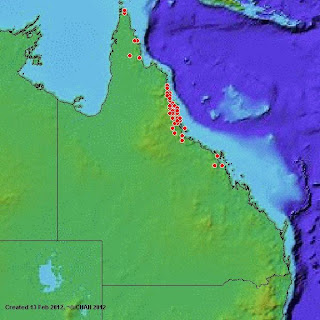Turn in the wind (Mallotus paniculatus, family Euphorbiaceae) is in fruit.
The leaves twist in the slightest breeze, showing the pale lower surface — a strong contrast to the emerald green above. A close up look reveals the dense hairs that cover the veins.
Two glands at the base of the leaf provide nectar to encourage ants to visit. In some plants, leaf damage increases production from extra-floral nectaries.
A common species at rainforest edges, it occurs along the Queensland coast from the Mackay region to Torres Strait. (See map below.) It is also found throughout Malesia and SE Asia.
 |
| Specimen data reproduced from Australia's Virtual Herbarium with permission of the Council of Heads of Australasian Herbaria Inc |
I was going to take more photos, but a pademelon ate the leaves. Paddies love turn in the wind leaves, as do possums. Here's more evidence if you need it. (Warning: Contains cuteness.)




